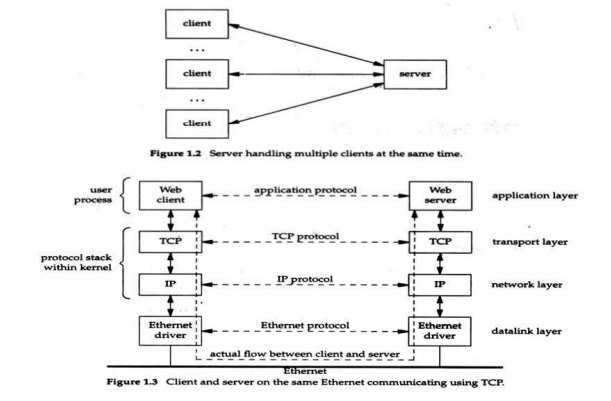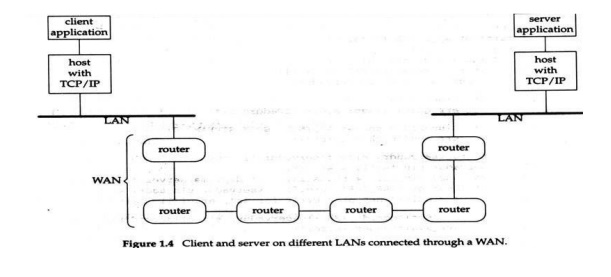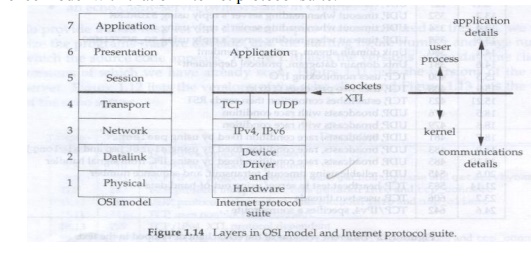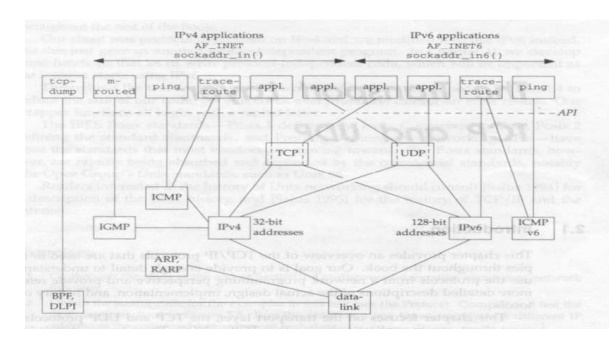Chapter: Network Programming and Management : Elementary TCP Sockets
Introduction to socket programming
Introduction:
Most network application can be divided into
two programs: client and server with the communication link between them as
shown:

Examples are : A web browser communicating with
a web server. A FTP client fetching a file form an FTP server etc. A client
normally communicates with a server at a time. However, a server is likely to
communicate with multiple client. The client and server communication with in
the same Ethernet and the communication when LAN connected through WAN is shown
below.


As seen in above figure , TCP and IP protocols
are normally part of the protocol stack within the kernal. In addition to TCP
and IP, other protocol like UDP is also used. IP that was in use since early
1980 is called as IP version 4 (Ipv4). A new version IP version 6 (Ipv6) is
being used since mid 1990.
OSI model for the Internet protocol suite: The
following figure provides the comparison of OSI reference model with that of
Internet protocol suite.

The upper three layers of OSI model are
combined into a single layer called the application. This is the Web Client
(Browser), Telnet client, the Web Server, FTP server or whatever application we
are using. The transport layer that are chosen are TCP and UDP. As shown in the
figure, it is possible to bypass both TCP and UDP and the application layer may
directly use Ipv4 or Ipv6. This is called raw socket.
The two program interface the we will be
studying are sockets and XTI(X/Open
Transport Interface) . It is
intended to study : how to write applications using either Sockets or XTI that
use either TCP or UDP. We need this
because, upper three layers handle all the details of the application (FTP,
Telnet or HTTP etc) and know little about the communication details. Whereas
the lower four layers know little about the application but handle all communication
details: sending data, waiting for an acknowledgement sequencing data that
arrives out of order , calculating and verifying the checksums and so on. Upper
three layers are normally provided as part of the operating system kernal.
The
Transport Layer:
The transport layer makes use of TCP and UDP
protocols. UDP is a simple, unreliable, datagram protocol while TCP is a
sophisticated, reliable, byte stream protocol. We need to understand the
services provided by these two transport layer to the application, so that we
know what is handled by the protocol and what we must handle in the
application.
Although, it is known as TCP / IP suite, there are more members to the family as shown below.

Both Ipv4, Ipv6 are shown in the above figure.
Moving from right to left in this figure, the rightmost four application are
using Ipv6. We need to understand AF_INET 6 and sockaddr_in6 in this. The next
five applications use Ipv4. The tcpdump communicates directly with the data
link using either BPF (BSD Packet Filter ) or DLPI (Data Link Provider
Interface). The dashed line marked as API is normally either sockets or XTI The
interface to BPF or DLPI does not use sockets or XTI. traceroute uses two
sockets : one for IP and other for ICMP. Each of the protocol is described
below.
IPv4: It provides the packet delivery service for
TCP, UDP, ICMP and IGMP. It uses 32 bit
address.
IPv6: It Is designed as replacement for IPv4. IT
has larger address made up of 128 bits.
It provides packet delivery service
for TCP, UDP and ICMPv6.
Related Topics